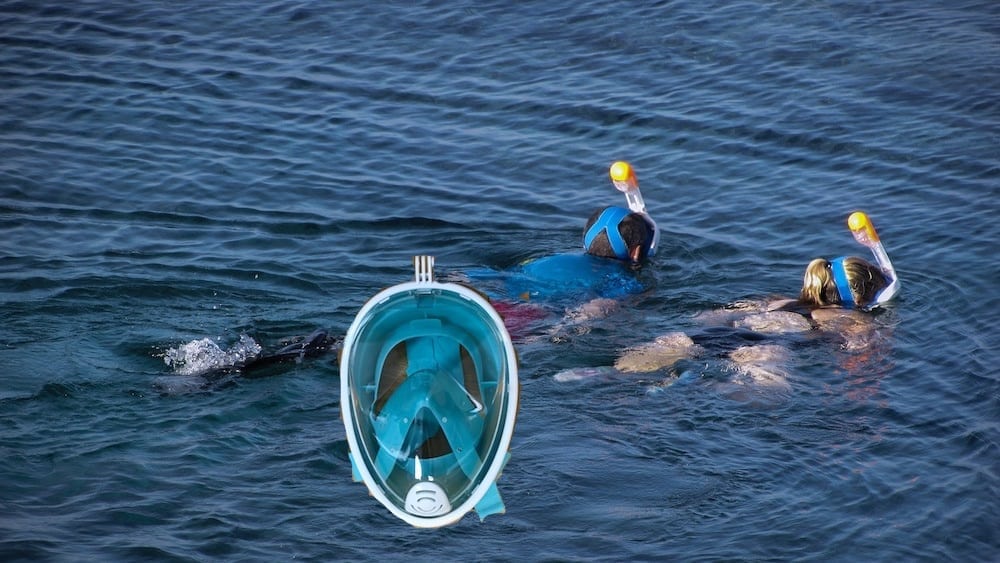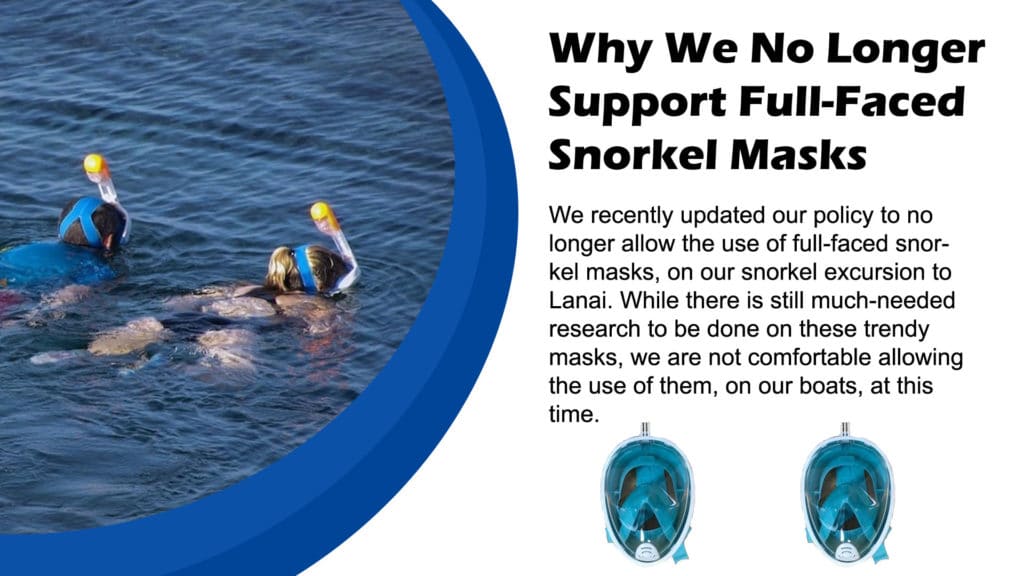A Visual Guide To Common Humpback Whale Behavior
There is nothing more exciting than seeing a 30-ton whale throwing itself out of the ocean like a spinner dolphin on one of our whale watches. Luckil...

We recently updated our policy to no longer allow the use of full-faced snorkel masks, on our snorkel excursion to Lanai. While there is still much-needed research to be done on these trendy masks, we are not comfortable allowing the use of them, on our boats, at this time.
If you are not familiar with the full-faced masks, rather than having a traditional mask, which is composed of two separate parts: the mask (that covers your eyes and nose) and snorkel (tube that clips, on the side, of the mask to deliver oxygen orally from above the water) combination, a full-faced mask covers your entire face with a fixed tube that extends out from the forehead-area for breathing. In theory, these full-faced masks create a wider viewing area, and are easier to operate as a person can breathe "normally," with both nose and mouth, without needing to get accustomed to using a snorkel. However, we believe the dangers of full-faced masks far outweigh the benefits.
In January, 2018, nine people passed away while snorkeling, and diving, in Maui's waters. It is important to note that, in Hawaii, the majority of snorkeling fatalities are visitors, who are inexperienced snorkelers,* and there are many factors to take into consideration, such as age and physical ability. However, at least two of the eight snorkelers (the ninth man was a scuba diver) died while wearing full-faced snorkel masks; a percentage, us locals, find to be alarming.

Fire Services Chief Ed Taomoto told the Maui News: “Recently, we have noticed that a number of snorkel-related drownings, or, near- drownings have involved these new one-piece masks, but it is too early to make any sort of connection to the use of this equipment and drownings. We’re not sure if the increase in incidents involving these new full-face type masks is related to a problem with this design or if there is just more people using this type over the traditional two-piece snorkel set.” Although there is an undeniable correlation, experts are still working on determining the exact causation.
As reported by Hawaii Civil Beat, Dr. Philip Foti, an Oahu physician who specializes in pulmonary and internal medicine, addressed a conference, regarding drowning prevention, in 2017, and stated this about full-faced masks: "...there is dead space ventilation in the device that seems greater than in the standard snorkel tube. That dead space can cause carbon dioxide buildup." This CO2 buildup could cause a person to become disoriented, or, even lose consciousness.
Another issue with the full-faced masks is that they appear to be prone to leaking and fogging up. Rather than creating a tight seal using silicone, around just the eye area, like a standard mask, many (not all) of these masks use lower-quality PVC to create the seal around the mask. As the PVC must cover the entire face, rather than just the eye area, the number of potential failure points is dramatically increased. Some have reported the simple act of squinting may cause leakage.** Because the masks cover the full face, once they fill with water, the user, literally, cannot breathe. Whereas, with a standard mask and snorkel, if the mask fills with water, you can still breath through the snorkel. To compound the matter, with straps that go completely around the head, removing the masks can be difficult. In a panic situation, remembering the steps to remove a full-faced mask may be forgotten.
While full-faced masks continue to sell well on Amazon (and get generally good reviews), and there are activity companies on Maui that will rent them, until further research is done on the full-faced masks, we are not allowing our guests to use them. If you bring one on-board, rest assured, you can still go out using the gear that we provide.
Finally, as an aside, in all nine water deaths, the men were swimming alone. We highly recommend snorkeling with a buddy, whether you're entering the ocean from the beach, or, out on a snorkeling tour with a licensed operator.
Please let us know your experiences with full-faced masks, and tell us what you think of our policy update in the comments below.
*As cited by deeperblue.com: data shows that tourists are 10 times more likely to drown than residents, and that the drowning rate on the islands is 13 times the national average.
There is nothing more exciting than seeing a 30-ton whale throwing itself out of the ocean like a spinner dolphin on one of our whale watches. Luckil...
When you join us on a whale watch tour on Maui, breaching is one of the common actions you're likely to see. Breaching is when a whale throws its ent...
Seeing whales on a whale watch tour is awesome. No doubt about that. But do you know what else is awesome? Seeing dolphins! But is it legal to swim wi...
